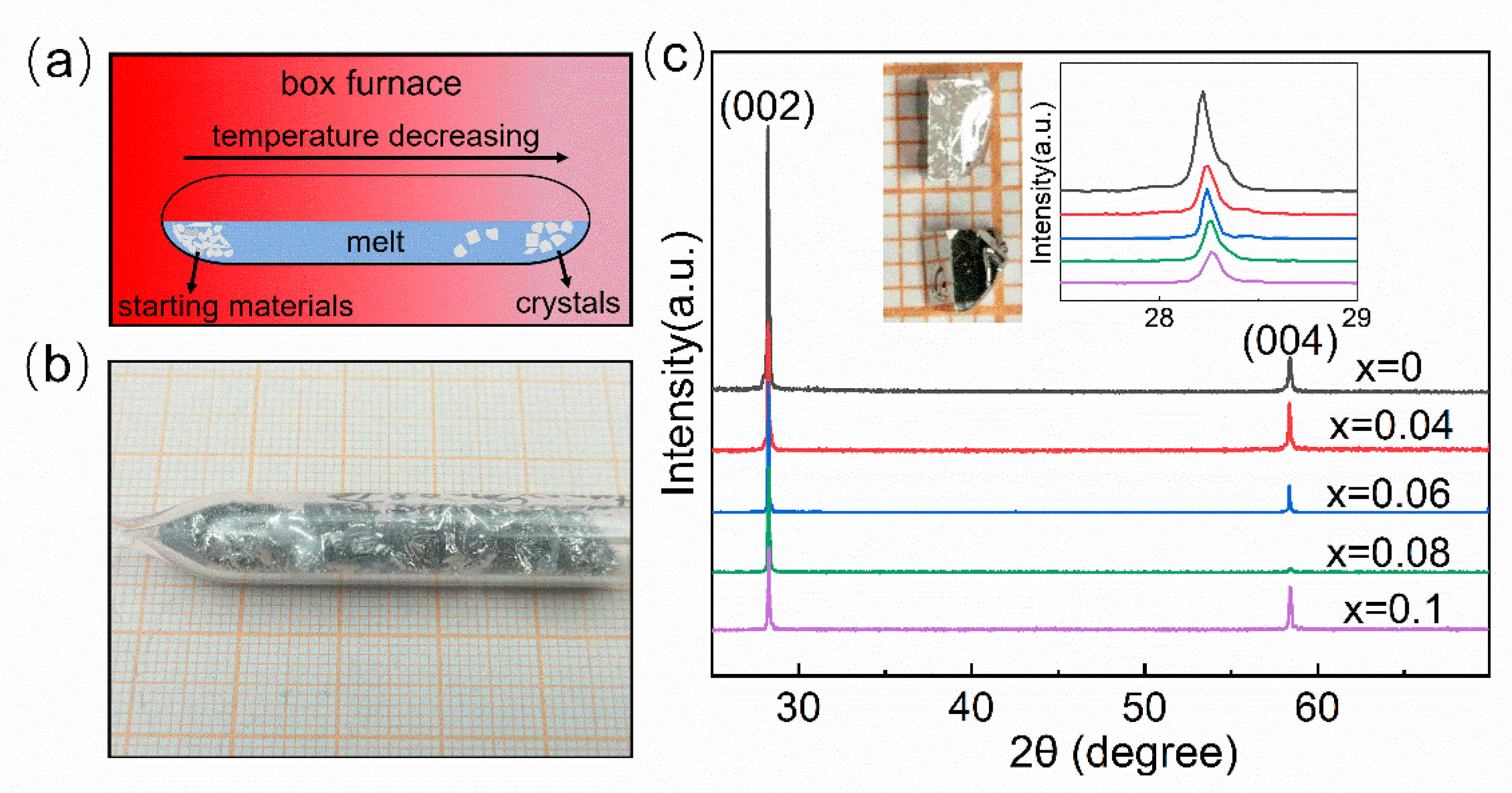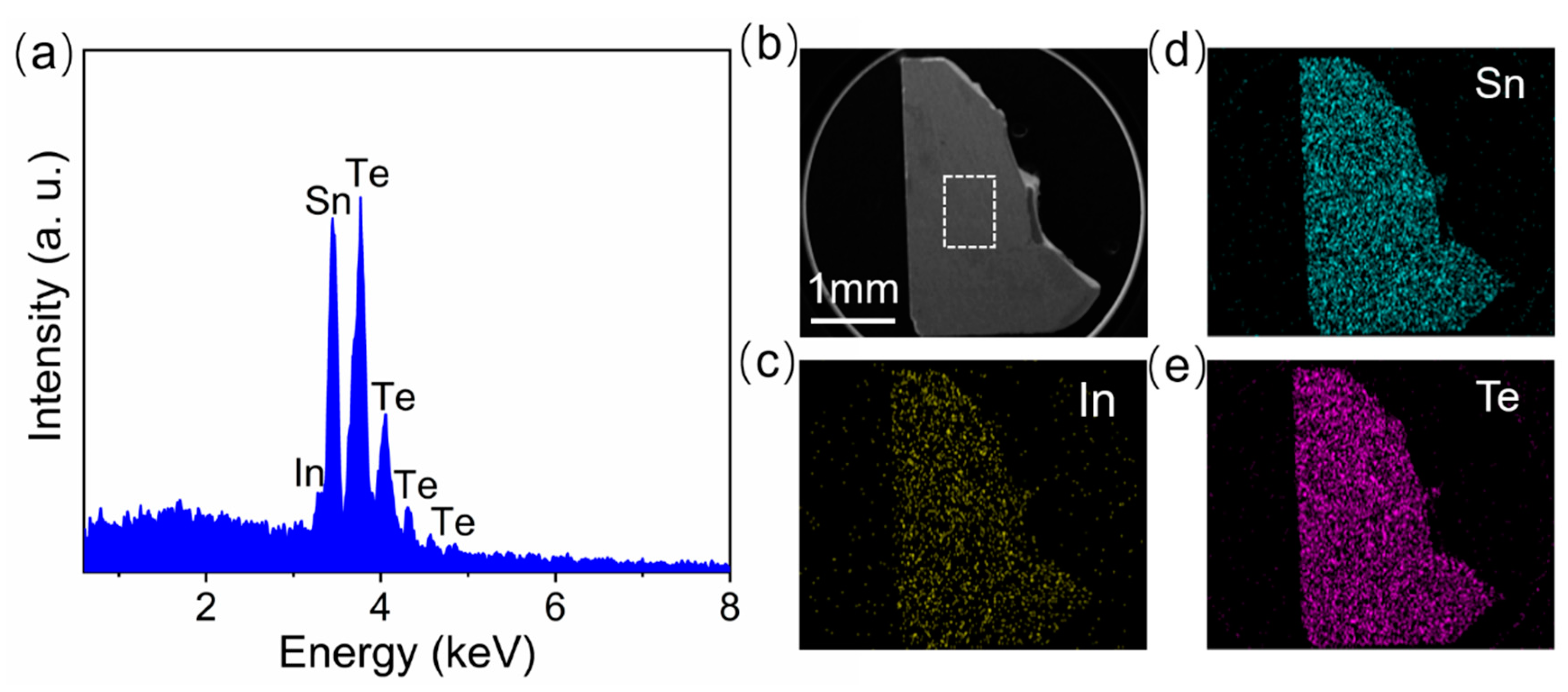Synthesis of Superconducting InxSn1−xTe (0.04 < x < 0.1) Large Single Crystal by Liquid Transport Method
Abstract
1. Introduction
2. Experimental Methods
3. Results and Discussion
Author Contributions
Funding
Institutional Review Board Statement
Informed Consent Statement
Data Availability Statement
Acknowledgments
Conflicts of Interest
References
- Kane, C.L.; Mele, E.J. Z2 Topological Order and the Quantum Spin Hall Effect. Phys. Rev. Lett. 2005, 95, 146802. [Google Scholar] [CrossRef]
- Zhang, H.; Liu, C.X.; Qi, X.L.; Dai, X.; Fang, Z.; Zhang, S.C. Topological Insulators in Bi2Se3, Bi2Te3 and Sb2Te3 with a Single Dirac cone on the Surface. Nat. Phys. 2009, 5, 438. [Google Scholar] [CrossRef]
- Hasan, M.Z.; Kane, C.L. Colloquium: Topological Insulators. Rev. Mod. Phys. 2010, 82, 3045–3067. [Google Scholar] [CrossRef]
- Hsieh, T.H.; Lin, H.; Liu, J.; Duan, W.; Bansil, A.; Fu, L. Topological Crystalline Insulators in the SnTe Material Class. Nat. Commun. 2012, 3, 982. [Google Scholar] [CrossRef] [PubMed]
- Ando, Y. Topological Insulator Materials. J. Phys. Soc. Jpn. 2013, 82, 102001. [Google Scholar] [CrossRef]
- Qi, X.L.; Zhang, S.C. Topological Insulators and Superconductors. Rev. Mod. Phys. 2011, 83, 1057. [Google Scholar] [CrossRef]
- Wilczek, F. Majorana Returns. Nat. Phys. 2009, 5, 614–618. [Google Scholar] [CrossRef]
- Mourik, V.; Zuo, K.; Frolov, S.M.; Plissard, S.R.; Bakkers, E.P.; Kouwenhoven, L.P. Signatures of Majorana Fermions in Hybrid Superconductor-Semiconductor Nanowire Devices. Science 2012, 336, 1003–1007. [Google Scholar] [CrossRef]
- Fu, L.; Kane, C.L. Superconducting Proximity Effect and Majorana Fermions at the Surface of a Topological Insulator. Phys. Rev. Lett. 2008, 100, 096407. [Google Scholar] [CrossRef]
- Hor, Y.S.; Williams, A.J.; Checkelsky, J.G.; Roushan, P.; Seo, J.; Xu, Q.; Zandbergen, H.W.; Yazdani, A.; Ong, N.P.; Cava, R.J. Superconductivity in CuxBi2Se3 and its Implications for Pairing in the Undoped Topological Insulator. Phys. Rev. Lett. 2010, 104, 057001. [Google Scholar] [CrossRef]
- Matano, K.; Kriener, M.; Segawa, K.; Ando, Y.; Zheng, G.Q. Spin-Rotation Symmetry Breaking in the Superconducting State of CuxBi2Se3. Nat. Phys. 2016, 12, 852–854. [Google Scholar] [CrossRef]
- Liu, Z.; Yao, X.; Shao, J.; Zuo, M.; Pi, L.; Tan, S.; Zhang, C.; Zhang, Y. Superconductivity with Topological Surface State in SrxBi2Se3. J. Am. Chem. Soc. 2015, 137, 10512–10515. [Google Scholar] [CrossRef] [PubMed]
- Shruti; Maurya, V.K.; Neha, P.; Srivastava, P.; Patnaik, S. Superconductivity by Sr Intercalation in the Layered Topological Insulator Bi2Se3. Phys. Rev. B 2015, 92, 020506(R). [Google Scholar] [CrossRef]
- Kobayashi, K.; Ueno, T.; Fujiwara, H.; Yokoya, T.; Akimitsu, J. Unusual Upper Critical Field Behavior in Nb-Doped Bismuth Selenide. Phys. Rev. B 2017, 95, 180503(R). [Google Scholar] [CrossRef]
- Erickson, A.S.; Chu, J.H.; Toney, M.F.; Geballe, T.H.; Fisher, I.R. Enhanced Superconducting Pairing Interaction in Indium-Doped Tin Telluride. Phys. Rev. B 2009, 79, 024520. [Google Scholar] [CrossRef]
- Sasaki, S.; Ren, Z.; Taskin, A.A.; Segawa, K.; Fu, L.; Ando, Y. Odd-Parity Pairing and Topological Superconductivity in a Strongly Spin-Orbit Coupled Semiconductor. Phys. Rev. Lett. 2012, 109, 217004. [Google Scholar] [CrossRef]
- Mizuguchi, Y.; Miura, O. High-Pressure Synthesis and Superconductivity of Ag-Doped Topological Crystalline Insulator SnTe (Sn1−xAgxTe with x = 0–0.5). J. Phys. Soc. Jpn. 2016, 85, 053702. [Google Scholar] [CrossRef]
- Sun, Y.; Kittaka, S.; Sakakibara, T.; Machida, K.; Wang, J.; Wen, J.; Xing, X.; Shi, Z.; Tamegai, T. Quasiparticle Evidence for the Nematic State above Tc in SrxBi2Se3. Phys. Rev. Lett. 2019, 123, 027002. [Google Scholar] [CrossRef]
- Wang, J.; Ran, K.; Li, S.; Ma, Z.; Bao, S.; Cai, Z.; Zhang, Y.; Nakajima, K.; Ohira-Kawamura, S.; Cermak, P.; et al. Evidence for Singular-Phonon-Induced Nematic Superconductivity in a Topological Superconductor Candidate Sr0.1Bi2Se3. Nat. Commun. 2019, 10, 2802. [Google Scholar] [CrossRef]
- Shen, J.Y.; He, W.Y.; Yuan, N.F.Q.; Huang, Z.L.; Cho, C.W.; Lee, S.H.; Hor, Y.S.; Law, K.T.; Lortz, R. Nematic Topological Superconducting Phase in Nb-doped Bi2Se3. NPJ Quantum Mater. 2017, 2, 7. [Google Scholar] [CrossRef]
- Novak, M.; Sasaki, S.; Kriener, M.; Segawa, K.; Ando, Y. Unusual Nature of Fully Gapped Superconductivity in In-Doped SnTe. Phys. Rev. B 2013, 88, 140502. [Google Scholar] [CrossRef]
- Zhong, R.D.; Schneeloch, J.A.; Shi, X.Y.; Xu, Z.J.; Zhang, C.; Tranquada, J.M.; Li, Q.; Gu, G.D. Optimizing the Superconducting Transition Temperature and Upper Critical Field of Sn1−xInxTe. Phys. Rev. B 2013, 88, 020505. [Google Scholar] [CrossRef]
- Haldolaarachchige, N.; Gibson, Q.; Xie, W.; Nielsen, M.B.; Kushwaha, S.; Cava, R.J. Anomalous Composition Dependence of the Superconductivity in In-Doped SnTe. Phys. Rev. B 2016, 93, 024520. [Google Scholar] [CrossRef]
- Zhang, C.; He, X.G.; Chi, H.; Zhong, R.; Ku, W.; Gu, G.; Tranquada, J.M.; Li, Q. Electron and Hole Contributions to Normal-State Transport in the Superconducting System Sn1−xInxTe. Phys. Rev. B 2018, 98, 054503. [Google Scholar] [CrossRef]
- Sato, T.; Tanaka, Y.; Nakayama, K.; Souma, S.; Takahashi, T.; Sasaki, S.; Ren, Z.; Taskin, A.A.; Segawa, K.; Ando, Y. Fermiology of the Strongly Spin-Orbit Coupled Superconductor Sn(1−x)In(x)Te: Implications for Topological Superconductivity. Phys. Rev. Lett. 2013, 110, 206804. [Google Scholar] [CrossRef] [PubMed]
- Polley, C.M.; Jovic, V.; Su, T.Y.; Saghir, M.; Newby, D.; Kowalski, B.J.; Jakiela, R.; Barcz, A.; Guziewicz, M.; Balasubramanian, T.; et al. Observation of Surface States on Heavily Indium-Doped SnTe(111), a Superconducting Topological Crystalline Insulator. Phys. Rev. B 2016, 93, 075132. [Google Scholar] [CrossRef]
- Maeda, S.; Hirose, R.; Matano, K.; Novak, M.; Ando, Y.; Zheng, G.Q. Spin-Singlet Superconductivity in the Doped Topological Crystalline Insulator Sn0.96In0.04Te. Phys. Rev. B 2017, 96, 104502. [Google Scholar] [CrossRef]
- Saghir, M.; Barker, J.A.T.; Balakrishnan, G.; Hillier, A.D.; Lees, M.R. Superconducting Properties of Sn1−xInxTe (x = 0.38–0.45) Studied Using Muon-Spin Spectroscopy. Phys. Rev. B 2014, 90, 064508. [Google Scholar] [CrossRef]
- Yan, J.Q.; Sales, B.C.; Susner, M.A.; McGuire, M.A. Flux Growth in a Horizontal Configuration: An Analog to Vapor Transport Growth. Phys. Rev. Mater. 2017, 1, 023402. [Google Scholar] [CrossRef]
- Wang, Z.; Segawa, K.; Sasaki, S.; Taskin, A.A.; Ando, Y. Ferromagnetism in Cr-Doped Topological Insulator TlSbTe2. APL Materials 2015, 3, 083302. [Google Scholar] [CrossRef]
- Wang, Z.; Taskin, A.A.; Frölich, T.; Braden, M.; Ando, Y. Superconductivity in Tl0.6Bi2Te3 Derived from a Topological Insulator. Chem. Mater. 2016, 28, 779–784. [Google Scholar] [CrossRef]
- Burke, J.R.; Allgaier, R.S.; Houston, B.B.; Babiskin, J.; Siebenmann, P.G. Shubnikov-de Haas Effect in SnTe. Phys. Rev. Lett. 1965, 14, 360–361. [Google Scholar] [CrossRef]





| x (Nominal) | Actual Composition | Lattice Parameters a (Å) | Tc (K) | Hc2 (T) | Carrier Density (1020 cm−3) | ||
|---|---|---|---|---|---|---|---|
| In | Sn | Te | |||||
| 0 | 0 | 1.046 | 1 | 6.3174 (4) | - | - | - |
| 0.04 | 0.039 | 1.004 | 1 | 6.3134 (3) | 1.57 | 0.68 | 3.37 |
| 0.06 | 0.046 | 1.001 | 1 | 6.3133 (4) | 1.61 | 0.71 | 4.68 |
| 0.08 | 0.070 | 0.987 | 1 | 6.3102 (6) | - | - | 6.96 |
| 0.1 | 0.081 | 0.949 | 1 | 6.3085 (9) | - | - | 9.60 |
Publisher’s Note: MDPI stays neutral with regard to jurisdictional claims in published maps and institutional affiliations. |
© 2021 by the authors. Licensee MDPI, Basel, Switzerland. This article is an open access article distributed under the terms and conditions of the Creative Commons Attribution (CC BY) license (https://creativecommons.org/licenses/by/4.0/).
Share and Cite
Zhu, P.; Li, Y.; Yang, X.; Yang, Y.; Zhang, X.; Lin, X.; Yang, F.; Li, X.; Wang, Z. Synthesis of Superconducting InxSn1−xTe (0.04 < x < 0.1) Large Single Crystal by Liquid Transport Method. Crystals 2021, 11, 474. https://doi.org/10.3390/cryst11050474
Zhu P, Li Y, Yang X, Yang Y, Zhang X, Lin X, Yang F, Li X, Wang Z. Synthesis of Superconducting InxSn1−xTe (0.04 < x < 0.1) Large Single Crystal by Liquid Transport Method. Crystals. 2021; 11(5):474. https://doi.org/10.3390/cryst11050474
Chicago/Turabian StyleZhu, Peng, Yongkai Li, Xiaohui Yang, Ying Yang, Xin Zhang, Xiao Lin, Fan Yang, Xiang Li, and Zhiwei Wang. 2021. "Synthesis of Superconducting InxSn1−xTe (0.04 < x < 0.1) Large Single Crystal by Liquid Transport Method" Crystals 11, no. 5: 474. https://doi.org/10.3390/cryst11050474
APA StyleZhu, P., Li, Y., Yang, X., Yang, Y., Zhang, X., Lin, X., Yang, F., Li, X., & Wang, Z. (2021). Synthesis of Superconducting InxSn1−xTe (0.04 < x < 0.1) Large Single Crystal by Liquid Transport Method. Crystals, 11(5), 474. https://doi.org/10.3390/cryst11050474










